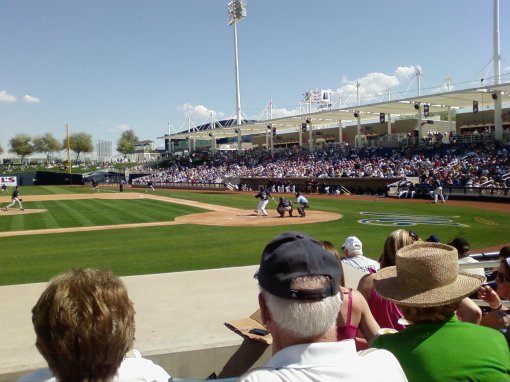I saw in Friday’s Chronicle that the Giants have released Dave Roberts. This demonstrates that the Giants — finally — understand the concept of sunk costs. The contract they gave Roberts at his advanced age was a mistake. They have admitted to themselves that although they will be paying Roberts some $6.5 million in 2009, he was going to be doing them no good, and they might as well put his roster spot to use evaluating someone younger who might be part of the next Giants team to win the division.
Although I think this is the right decision for the Giants, we should remember all that Roberts accomplished. Roberts wasn’t supposed to be a major leaguer in the first place. Guys who are supposed to be major leaguers don’t last until the 28th round, which is where the Tigers drafted Roberts after his senior season at UCLA. He quickly proved to be more than just a track star in cleats, but he didn’t reach Double-A until he was almost 25. In 1998 he hit .326/.434/.466 in the Southern League before the Tigers traded him to Cleveland. He was even better after the trade, smoking the ball to the tune of .361/.447/.542; his efforts wouldn’t even earn him a courtesy September callup.
He was traded (along with Tim Worrell) for the remains of Geronimo Berroa’s career, starting a trend in which Roberts would be traded every year or two for a lot less than he was worth. Three years later, the Indians would trade him to the Dodgers for two minor leaguers who would forever stay minor leaguers. At the 2004 trading deadline, he was sent to Boston for Henri Stanley, a name that only members of the Sons of Sam Horn message board recognize. Five months later, he was dealt yet again, this time to San Diego for three players and cash, which sounds nice until you read the names of those three players: Jay Payton, Ramon Vazquez, and Dave Pauley. At least the Red Sox got the cash.
Along the way Roberts would get the opportunity to play a little. After a disappointing debut in 1999, he batted just 26 times over the next two years. He finally held down a starting job after joining the Dodgers in 2002, at which point he was 30 years old. He made up for the late start to his career by doing pretty much what he’s done ever since: hit for a decent average (.277), draw some walks (.353 OBP), and steal bases with great efficiency (45 SB, 10 CS). In 2003, he was 40-of-54 on the basepaths. In 2004, he set the all-time NL record for most steals in a season (33) with no more than one caught stealing. He then joined the Red Sox and stole five or six more bases, none of any real consequence. He was on the roster for the team’s playoff run but was of such little use that he didn’t bat once in October; undoubtedly the team would have won without him. (Irony off.)
Roberts then returned to the NL West, where the immense ballparks are a perfect fit for his brand of speed, defense, and all the power of a San Francisco supervisor. For his career Roberts has stolen 243 bases while being caught just 58 times. That’s a stolen base percentage of 80.7 percent. In major league history, he ranks 11th in stolen base percentage among players with 200 or more attempts:
Player SB CS SB%
Carlos Beltran 275 37 88.1%
Tim Raines 808 146 84.7%
Eric Davis 349 66 84.1%
Willie Wilson 668 134 83.3%
Barry Larkin 379 77 83.1%
Tony Womack 363 74 83.1%
Davy Lopes 557 114 83.0%
Stan Javier 246 51 82.8%
Carl Crawford 302 64 82.5%
Julio Cruz 343 78 81.5%
Dave Roberts 243 58 80.7%
More significantly, Roberts is one of the few major leaguers to earn a reputation as a big-league speedster almost entirely in his thirties. Through his age-29 season, Roberts had only 12 career steals; he has 231 since, and counting. In major league history, no player with fewer than 50 steals before age 30 has stolen more bases after age 30 than Roberts. (The closest is Jimmy Austin, a St. Louis Browns’ third baseman of yore who stole 30 bases before turning 30, and 214 afterwards.) Roberts has 219 more steals after turning 30 than before, a number that ties him for fifth all-time:
Player SB < 30 SB > 30 Diff.
Otis Nixon 105 515 410
Davey Lopes 99 458 359
Lou Brock 334 604 270
Honus Wagner 239 464 225
Sam Rice 66 285 219
Dave Roberts 12 231 219
Davey Lopes is probably the best comp for Dave Roberts; both were late bloomers who got their shot with the Dodgers and became everyday players noted for their speed, and who occasionally put up sensational stolen base numbers. (Lopes was 45-of-49 in steals in 1978, 44-of-48 in 1979, and 47-of-51 in 1985, when he was 40 years old and only appeared in 99 games.) Lopes was the better player given his surprising power; the 5’9”, 170-pounder hit 155 career home runs, including 28 in 1979. Roberts, on the other hand, has had random strangers approach him to say “thank you” every day for the last four years, and quite likely will never have to pay for a drink in New England for the rest of his life.


